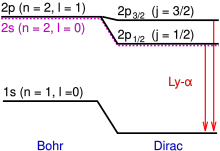Lyman-alpha, typically denoted by Ly-α, is a spectral line of hydrogen (or, more generally, of any one-electron atom) in the Lyman series. It is emitted when the atomic electron transitions from an n = 2 orbital to the ground state (n = 1), where n is the principal quantum number. In hydrogen, its wavelength of 1215.67 angstroms (121.567 nm or 1.21567×10 m), corresponding to a frequency of about 2.47×10 Hz, places Lyman-alpha in the ultraviolet (UV) part of the electromagnetic spectrum. More specifically, Ly-α lies in vacuum UV (VUV), characterized by a strong absorption in the air.
Fine structure

Because of the spin–orbit interaction, the Lyman-alpha line splits into a fine-structure doublet with the wavelengths of 1215.668 and 1215.674 angstroms. These components are called Ly-α3/2 and Ly-α1/2, respectively.
The eigenstates of the perturbed Hamiltonian are labeled by the total angular momentum j of the electron, not just the orbital angular momentum l. In the n = 2, l = 1 orbital, there are two possible states, with j = 1/2 and j = 3/2, resulting in a spectral doublet. The j = 3/2 state has a higher energy and so is energetically farther from the n = 1 state to which it is transitioning. Thus, the j = 3/2 state is associated with the more energetic (having a shorter wavelength) spectral line in the doublet.
Observation
Since the hydrogen Lyman-alpha radiation is strongly absorbed by the air, its observation in laboratory requires use of vacuumed spectroscopic systems. For the same reason, Lyman-alpha astronomy is ordinarily carried out by satellite-borne instruments, except for observing extremely distant sources whose redshifts allow the line to penetrate the Earth atmosphere.
The line was also observed in antihydrogen. Within the experimental uncertainties, the measured frequency is equal to that of hydrogen, in agreement with predictions of quantum electrodynamics.
See also
References
- Kramida, Alexander; Ralchenko, Yuri (1999), NIST Atomic Spectra Database, NIST Standard Reference Database 78, National Institute of Standards and Technology, retrieved 2021-06-27
- Draine, Bruce T. (2010). Physics of the Interstellar and Intergalactic Medium. Princeton, N.J.: Princeton University Press. p. 83. ISBN 978-1-4008-3908-7. OCLC 706016938.
- Ahmadi, M.; et al. (22 August 2018). "Observation of the 1S–2P Lyman-α transition in antihydrogen". Nature. 560 (7720): 211–215. doi:10.1038/s41586-018-0435-1. PMC 6786973. PMID 30135588.
| Hydrogen spectral series | |
|---|---|